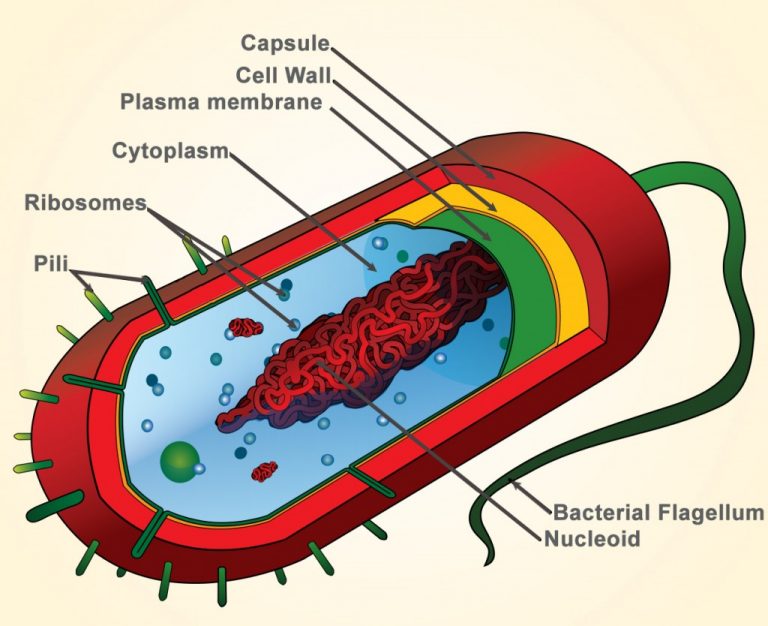

Bacterial DNA is naked (lacked histone protein).Bacterial nucleus is known as nucleoid it lacks nuclear membrane, nuceloplasm and nucleolus.It controls and directs all the cellular activities and stores hereditary information of cell.Nucleus is the most important part of the cell.

It is selectively permeable as it allows to pass selective substances such as sugar, aminoacids across it.Cell membrane of bacteria is composed of phospholipid and proteins.It is also known as cytoplasmic membrane or plasma membrane.Cell membrane is the inner layer that lies inside the cell wall and encloses the cytoplasm.Polysaccharide: it consists of core-polysaccharide and O-polysaccharide.Lipid-A: it is phosphorylated glucosamine disaccharide.LPS is composed of lipid-A and polysaccharide.It is composed of lipid bilayer, protein and lipo-polysaccharide(LPS).It is an additional layer present in gram negative bacteria.It is the major surface antigen of gram positive bacteria.It constitutes about 50% of dry weight of cell wall.Teichoic acid is water soluble polymer of glycerol or ribitol phosphate present in gram positive bacteria.However, gram positive have thick layer of peptidoglycan. Peptidoglycan layer is present in cell wall of both gram positive as well as gram negative bacteria.It consists of glycan backbone formed by repeated unit of NAG (n-acetyl Glucosamine) and NAM (N-acetyl muramic acid) and the glycan backbone is cross linked by peptide bond.Some stalked bacteria are: Gallionella, Planctomyces.It is formed by excretory product of bacteria.


Some prosthecae develop bud at the tip and hence helps in reproduction.One bacteria may contains one or many prosthecae.Prosthecae are semi-rigid extension of cell wall and cell membrane.Sometime sheath is impregnated with ferric or manganese hydroxide which provide strength to sheath.Some sheathed bacteria are Sphaerotilus, leptothrix, clonothrix etc.Some bacteria forming chain or trichome are enclosed by a hollow tube like structure known as Sheath.F-pili also act as receptor for bacteriophage.Sex pilus (F-pili) help in transfer of DNA from donor to recipient cell during conjugation. Specialized function: some pili are modified for specialized function.Pili (fimbrae) possess antigenic property.Most of the human pathogens of respiratory tract, urinary tract are attached with the help of pili. Attachment: pili helps the bacteria to attach the host cell surface.Bacteria containing pili: Shigella, Proteus, Neisseria gonorrhoae, E.Pili is the characteristic feature of gram –ve bacteria.They are numerous and shorter than flagella.Pili are hollow filamentous and non-helical structure.It is composed of flagellin protein (globular protein) and known as H antigen. Flagella is not straight but is helical.It is 15-20 nm hair like helical structure emerges from cell wall.It helps in attachments as well as it prevent the cell from desiccation and drying.It can be removed by vigorous washing.Capsule is most important virulence factor of bacteria. Microcapsule: thickness less than 0.2µm, visible under Electron microscope Macro-capsule: thickness of 0.2µm or more, visible under light microscope Capsule is 98% water and 2% polysaccharide or glycoprotein/ polypeptide or both.Capsule is 0.2µm thick viscus layer outer layer to the cell wall.The bacterial nucleus is known as nucleoid.Ī typical bacterial cell have following structure. Bacteria also lacks true membrane bound nucleus and nucleolus. It lacks all membrane bound cell organelles such as mitochondria, lysosome, golgi, endoplasmic reticulum, chloroplast, peroxisome, glyoxysome, and true vacuole. Bacterial cell have simpler internal structure. Bacterial are unicellular prokaryotic organism.


 0 kommentar(er)
0 kommentar(er)
